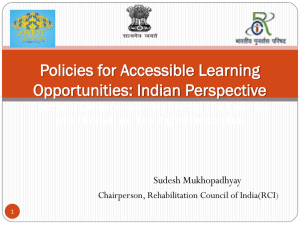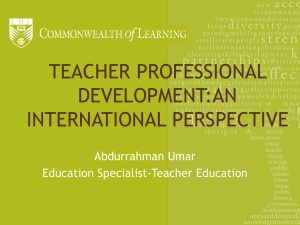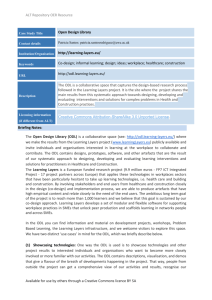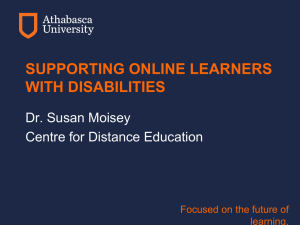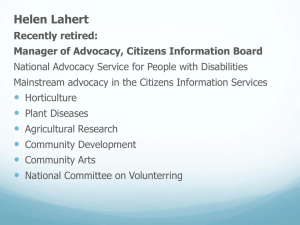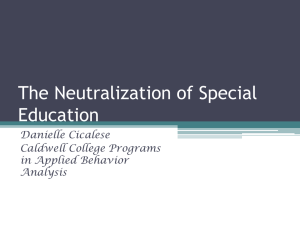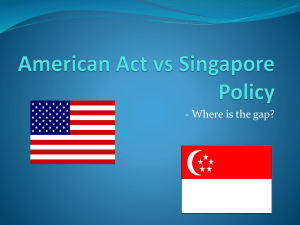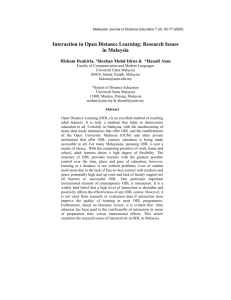dianne_chambers_session_9
advertisement
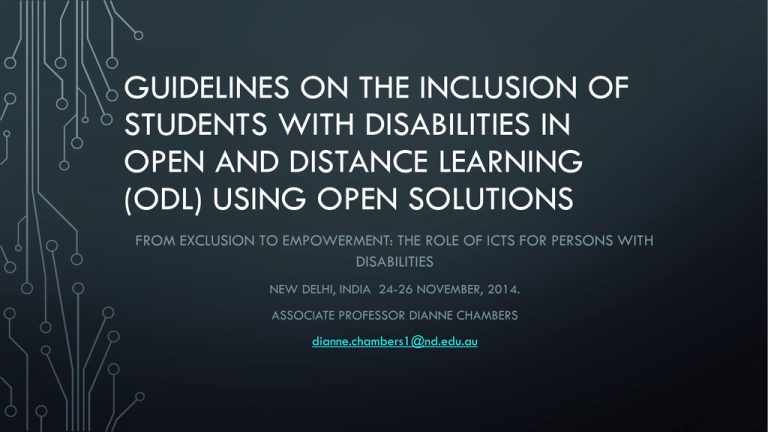
GUIDELINES ON THE INCLUSION OF STUDENTS WITH DISABILITIES IN OPEN AND DISTANCE LEARNING (ODL) USING OPEN SOLUTIONS FROM EXCLUSION TO EMPOWERMENT: THE ROLE OF ICTS FOR PERSONS WITH DISABILITIES NEW DELHI, INDIA 24-26 NOVEMBER, 2014. ASSOCIATE PROFESSOR DIANNE CHAMBERS dianne.chambers1@nd.edu.au 15% (1 billion) people in the world have a disability. It is vital that they are able to access appropriate education. RATIONALE In some countries distance education is provided at all levels of education, including primary, secondary and tertiary levels. Development is not at the same level or pace in every country. Developed by UNESCO, in close collaboration with international, regional and national partners. Contribute to the implementation of relevant articles of the United Nations Convention on the Rights of Persons with Disabilities (UN, 2006). Stakeholders include: policy and decision makers, distance learning institutions, quality assurance and recognition bodies, educational institutions, teacher associations, civil societies dealing with disability issues, families and persons with disabilities. The guidelines build on lessons learned from champions of distance learning and their experience dealing with disability issues. Central to these guidelines is how open solutions (e.g. Open Educational Resources – OER; Free and Open Source Software – FOSS) can ensure that technological developments, new pedagogical approaches, software and course content are provided in diverse formats Such guidelines do not currently exist and their development and use may lead to a more ethical, and sustainable world, a world where everyone would have access to education. PURPOSE OF THE GUIDELINES • To provide a foundation for governments, civil society organisations, industry and educational institutions to incorporate the needs of persons with disabilities in open and distance learning (ODL). • The wide range of available open and distance learning (ODL) methods, in tandem with open educational solutions (e.g. Open educational resources – OER and free open source software - FOSS), can enable persons with disabilities to learn and contribute knowledge and skills to their communities. • Accessibility should be one of the criteria used by quality assurance and recognition bodies as well as other relevant stakeholders in their working processes and practices. DEFINITIONS Persons with Disabilities • Persons with disabilities include those who have long-term physical, mental, intellectual or sensory impairments which in interaction with various barriers may hinder their full and effective participation in society on an equal basis with others (UN Convention on the Rights of Persons with Disabilities [UNCRPWD], 2006, Article 1, para. 2). DEFINITIONS-ODL Open and Distance Learning (ODL) • refers to the provision of flexible educational opportunities in terms of access and multiple modes of knowledge acquisition . • The term ‘Open’ in Open and Distance Learning (ODL) refers to “…any scheme of education or training that seeks systematically to remove barriers to learning, whether they are concerned with age, time, place or space. With open learning, individuals take responsibility for what they learn, how they learn, where they learn, how quickly they learn, who helps them and when they have their learning assessed” (Distance Learning UK, 2003, para 1). • The use of open in open solutions refers to software and courseware that is freely available, or open, to all users, at prescribed levels of access. DEFINITIONS - OER Open Education Resources (OERs) • Open Educational Resources (OERs) are any type of educational materials that are in the public domain or introduced with an open license . • OERs range from textbooks to curricula, syllabi, lecture notes, assignments, tests, projects, audio, video and animation. OERs “…allows users to legally and freely use, copy, adapt, and re-share” . DEFINITIONS – FOSS & OA • Free and open source software (FOSS) • refers to software that has been designed by a person or group and then distributed freely for use. • Open access to scientific information (OA) • is the provision of free access to peer –reviewed scholarly and research information for all . RESEARCH • Areas examined in the literature on ODL and persons with disabilities include: • legal and technical issues; • supports and services; • efficacy of distance education; and • impacts for students with specific disabilities (e.g. hearing impairment , learning disability, physical impairment) • Findings indicate that increasing numbers of persons with disabilities are enrolling into distance education courses and that there is huge potential for ODL to have a significant impact on the educational pathway of many persons with disabilities EXISTING GUIDELINES ON INCLUDING PERSONS WITH DISABILITIES IN ODL • Few guidelines exist and these generally refer to specific countries (within particular legal frameworks, see section 508 in the USA) or contexts (e.g. specific jurisdictions, remote areas) . • A review of the literature identified one set of guidelines that specifically addressed accessible distance education (Distance Education Accessibility Guidelines: California Community Colleges) while other guidelines addressed online learning in general. • Most guidelines refer to the concept of Universal Design for Learning as having a key impact on deliberations for the design of an inclusive course . Universal Design is a cost-effective and sustainable way to achieve equitable outcomes for all people. • • UDL not only requires the design of accessible information, but also an accessible pedagogy. • Students with disabilities must have access to all components of the course that would be available to students without a disability. Existing guidelines in relation to persons with disabilities often refer to web-based or online learning or accessibility, without taking into account those ODL courses that may be offered as a print-based course or as a blend of print and electronic media. GUIDELINES FOR MAKING OPEN AND DISTANCE LEARNING ACCESSIBLE FOR PERSONS WITH DISABILITIES • Address those actions that governments, institutions, teacher associations, civil society associations, industry and regional quality assurance and recognition bodies should consider to be pre-requisite (or introductory) actions, implementation considerations, and monitoring processes for new and existing ODL using open solutions such as OERs or FOSS. ACTIONS Prerequisite Actions • Selecting Platforms • Devising Content • Considering Modalities Implementation Actions • Using Platforms • Streamlining Content • Supporting Modalities Monitoring Processes • Assessing and Adjusting Platforms • Determining Suitability of Content • Examining Modalities GUIDELINES FOR GOVERNMENTS Support and foster legislation and/or policy development to ensure persons with disabilities are considered in Open and Distance Learning (ODL). Facilitate liaison between all stakeholders in ODL. Facilitate access of Persons with disabilities to appropriate assistive technology to enhance access to ODL. Support the inclusion of Free and Open Source Software (FOSS), Open Educational Resources (OER) and Open Access (OA) research in educational documentation. Facilitate the development of appropriate infrastructure to support ODL for persons with disabilities. Improve the training for instructors so that they can effectively work with students with disabilities in ODL. Work together with organisations and associations for persons with disabilities to identify difficulties and solutions. GUIDELINES FOR INSTITUTIONS Give deliberate consideration to the potential enrolment of persons with disabilities in ODL and the need to include differing modalities of educational delivery Ensure that content is designed with Universal Design for Learning (UDL) principles in mind. Ensure that content is adaptable for a variety of users and contexts. Examine Free and Open Source Software (FOSS), Open Educational Resources (OER) and Open Access to scientific research (OA) with a view to addressing accessibility issues. Consider and address training requirements of users and familiarity with technology. Ensure that assistive technology is able to be used to further remove barriers to learning. Ensure that regular feedback mechanisms are in place. Establish support services and advertise these to all participants. GUIDELINES FOR INSTRUCTORS Seek information on the functional capabilities of all students. Include appropriate pedagogies which are accessible to as many participants as possible. Initiate periodic contact with students to assess progress. Actively examine content for accessibility on a regular basis. Modify content according to context and modality use. Seek OER and FOSS solutions for difficulties that may arise. Collect and collate data on student experiences and then apply for next iteration of the ODL. GUIDELINES FOR QUALITY ASSURANCE AND RECOGNITION AUTHORITIES Apply principles of fair and non-discriminatory recognition of qualifications undertaken in non-traditional modes (such as online and distance learning) established in UNESCO’s regional recognition conventions. Develop understanding of issues related to ensuring the inclusion of persons with disabilities in ODL. Consider the particular areas where quality assurance and recognition criteria may need to be re-visited to ensure quality teaching and learning for persons with disabilities in ODL. ASSISTIVE TECHNOLOGY Impairment Type Vision Considerations Students may have limited (or no) vision and be unable to view online or printed materials in the same way as others. Hearing Students will have difficulty with audio inputs on video or with participating on online or telephone discussions. Mobility Students may not be able to operate a mouse or keyboard. They may also have difficulty accessing buildings (if required) for any face-to-face course component. Learning Disability Students may have difficulty with reading, writing, and processing information quickly or retaining information in the same way as others. Speech Students may have difficulty contributing to interactive sessions (e.g. videoconferences). Example Accommodations Screen Reader Software Braille Refreshable Display Text-only browser Text alternatives for graphics/non-text Adjust contrast Text captioning or transcripts for audio/video Sign language interpreters Relay service (& TTY) Printed material Alternative keyboard or mouse Speech recognition software Accessible buildings Switch interfaces Page turners Books on CD, Tablet or USB Speech output on computer Speech input to assist with writing Text at an appropriately readable level Use email or a chat room (where the student can type a response) to convey thoughts and ideas CONCLUSION • Open and Distance Learning (ODL), coupled with free and open solutions, has great potential to enhance educational opportunities for persons with disabilities. • Tools are available to developers and instructors to support their efforts in ensuring suitability of materials for a wide range of users, and can be used prior to, and during, implementation of ODL courses. • These guidelines provide an overview for instructional designers and instructors when developing ODL courses, with a view to incorporating the needs of all users.
